A detailed explanation of the technical principles of the Mango Network transaction-based full-chain infrastructure network
In 2024, the blockchain industry will usher in a new round of paradigm shift, and full-chain narrative is becoming an industry theme.Mango Network ($MGO) The new Layer 1 public chain positioned as a transaction-based full-chain infrastructure network is leading a new round of innovation in the DeFi industry with its advantages of high performance, modularity, and the concept of a full-chain liquidity pool.
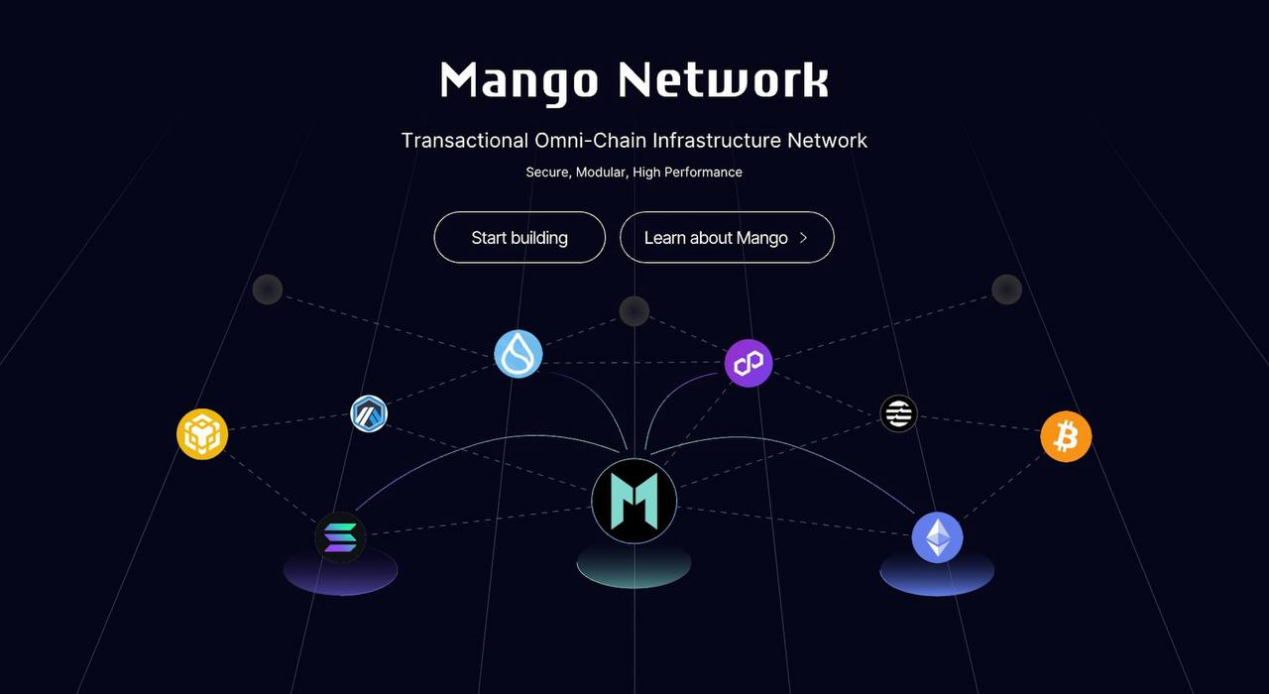
——The Mango public chain will be launched soon, supporting the seamless transmission of tokens, NFTs, data and information between heterogeneous L1/L2 public chains.
——Crypto assets and liquidity pools separated by different public chains can be efficiently transferred throughout the chain through Mango.
——Mango’s full-chain application has spawned full-chain liquidity pools, providing new possibilities for Web3, especially DeFi innovation.
In the past 2023, the global blockchain field has experienced a bullish and bearish transition. The annual narrative has gone through the second-layer network. Metas new public chain mainnet is online, LayerZero cross-chain competition, BRC 20 inscription breaks the MEME circle, with the influx of more users and With the richness of industry ecological use cases, multi-chain users have an increasingly strong demand for seamless interaction across the entire chain; on the other hand, the entire industry has increasingly realized that building a full-chain infrastructure is the most direct and effective way to break the impossible triangle of blockchain. Through various channels, full-chain narrative is becoming an industry theme, leading a new round of paradigm shift in 2024.
Facing the pain points of the industry, Mango Network ($MGO) took the lead in taking the lead, aiming to become a Layer 1 new public chain of the transaction-based full-chain infrastructure network. It will bring more security to users by building a one-stop liquidity service full-chain network. Trustworthy, diverse assets, convenient and independent full-chain trading experience.
Based on Move, natural security guarantee
Move language is the precious legacy of Facebooks super-sovereign cryptocurrency project Libra. It makes up for the shortcomings of Solidity and EVM. It is a programming language specially built for encrypted assets and provides high performance, security and reliability for blockchain applications. smart contract programming environment.
Mango Move is a statically typed programming language with multi-threading capabilities that can effectively reduce concurrency. Static language combined with smart contracts provides a safe environment for application development, and the project source code will not be tampered with when attacked. Moreover, the Move language treats digital assets as first-class citizens and specifically defines Token as an independent resource category (Resource), distinguished from other data. Mango Moves asset transfer is an object transfer, which ensures the uniqueness and security of assets, adding a layer of security to DeFi projects on the chain.
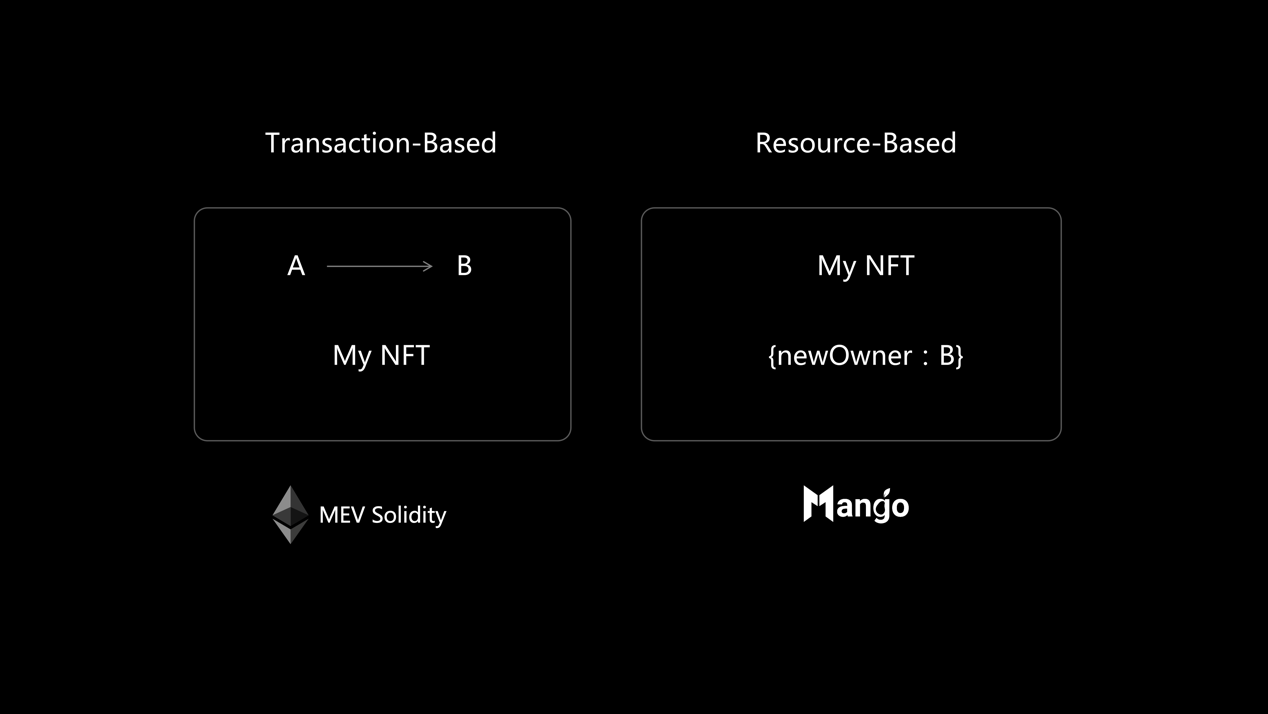
Modular high performance, breaking the impossible triangle
The Mango modular blockchain built based on the Mango Move language decomposes blockchain functions into different levels of network architecture, achieving high security, high performance, and low cost, breaking the impossible triangle of decentralized networks.
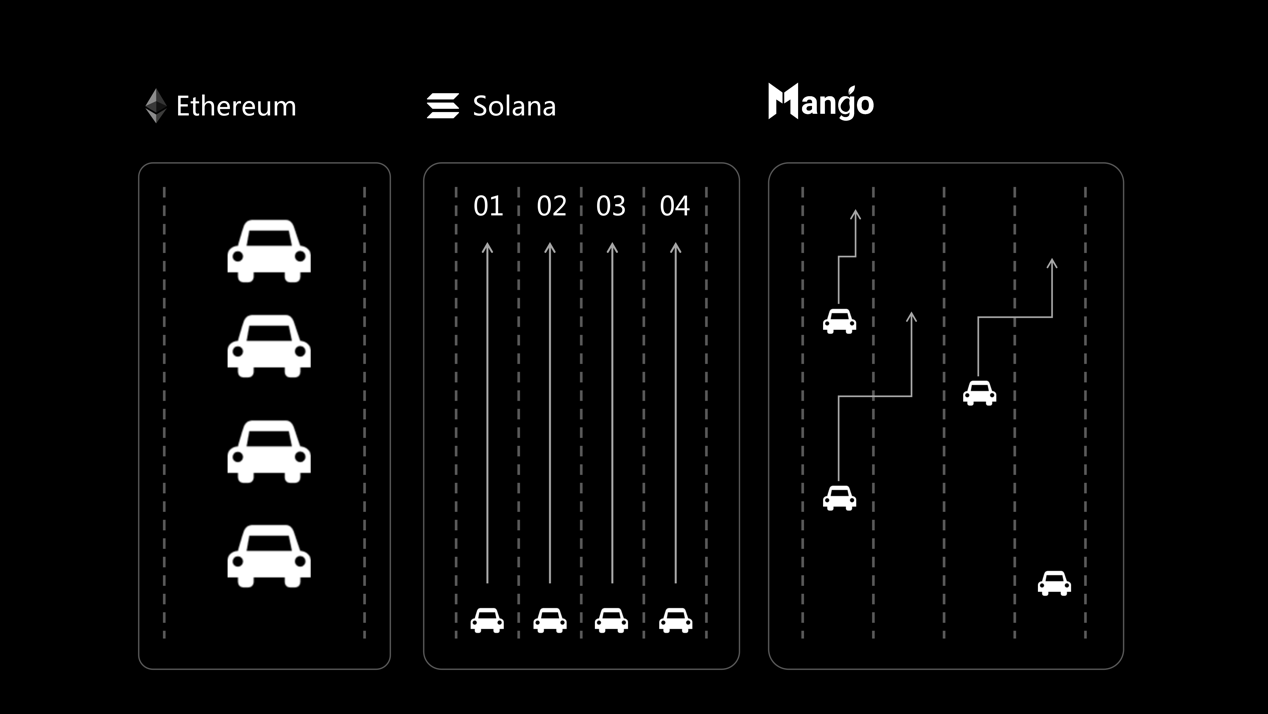
Traditional blockchain systems usually integrate functions such as consensus, settlement, data availability and execution into a single architecture. As the complexity and requirements of blockchain applications increase, a single architecture will not be able to meet the requirements of different scenarios.
The Mango modular blockchain separates these core functions, allowing each functional module to operate independently while maintaining collaboration with each other. This architecture makes the blockchain system more flexible and scalable, and can be customized and optimized according to different needs.
Through features such as horizontal scalability, composability, and on-chain storage, the Mango public chain can achieve parallel transaction processing and sub-second settlement of more than 100,000 TPS per second, and supports a wealth of on-chain assets, while delivering unparalleled speed and low cost. The cost feature solves the common pain points of L1 and brings an amazingly good user experience to developers and users.
Born into the whole chain, pioneering new application paradigms
As an L1 public chain positioned for full-chain applications, Mangos biggest advantage is that it can become an efficient execution layer and settlement layer, allowing developers to design the overall application from the perspective of full-chain interoperability, and users can use any L1 and L2 public chain access program applications significantly reduce the complexity of user operations.
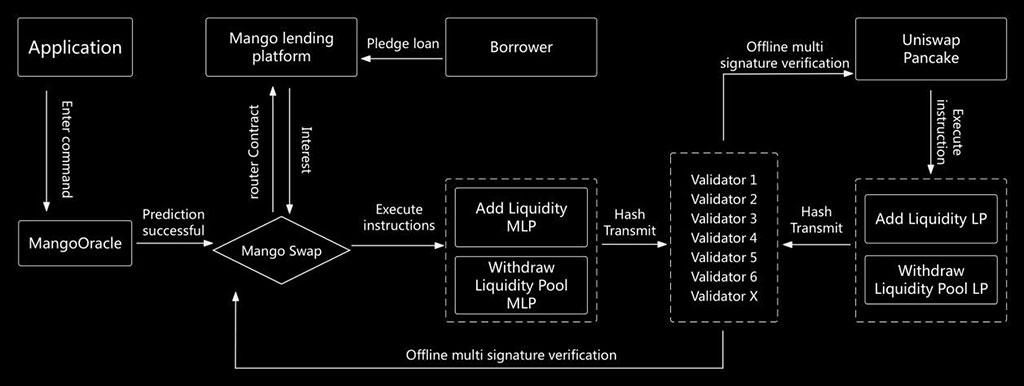
The technical architecture of Mangos full-chain application consists of Mango main chain contracts and module contracts. The main logic of the application is stored in the Mango main chain to achieve total control, and then remote access modules are built on other chains to implement communication with end users. Interaction, obtain user input, and output the results the user wants.
For example, DEX developers can deploy dApps on the Mango main chain, and users can operate applications from the Mango main chain or through remote access modules on any other chain, just as conveniently as accessing local programs. This also means that users only need to prepare one kind of Token as Gas, and can achieve any cross-chain operation without knowing which chain the dApp is actually deployed on.
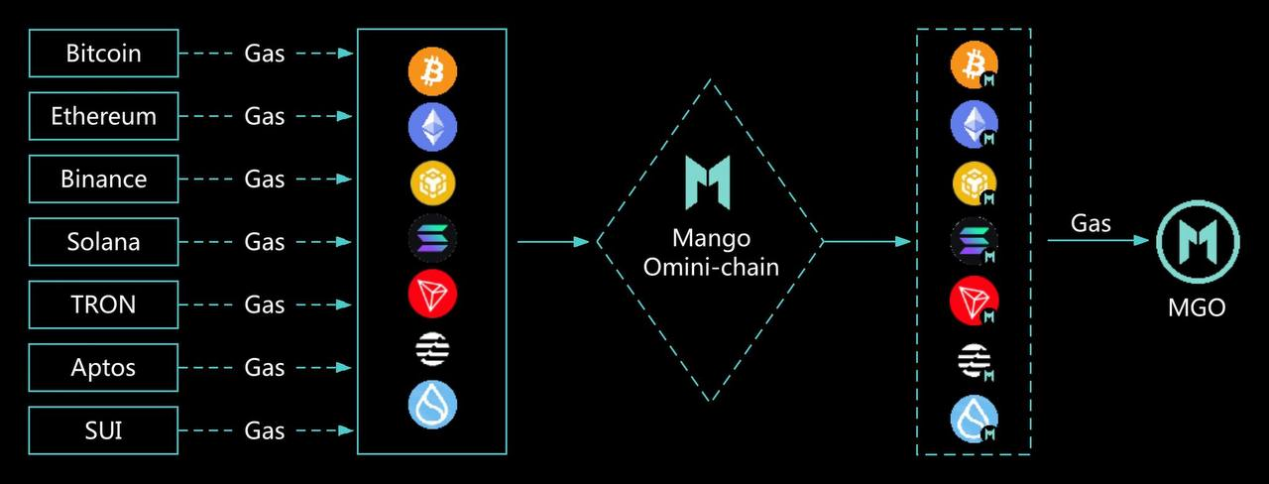
The biggest advantage of Mangos full-chain application technology architecture is that it significantly reduces the complexity of cross-chain integration. When the main logic of the program is processed on one chain of the Mango main chain, the application has a unified status record. After users deploy contracts on a new chain, they can inherit all state records and liquidity from the entire main chain. At the same time, when other applications integrate the program, they only need to dock on the full chain main chain to use all its functions and liquidity.

Compared with cross-chain protocols such as LayerZero, Mangos full-chain application does not require frequent asset cross-chains between different blockchain networks. It has lower usage costs, fast confirmation, and higher efficiency. At the same time, full-chain transactions do not require assets or data to be stored in third-party institutions, so asset security is also higher.
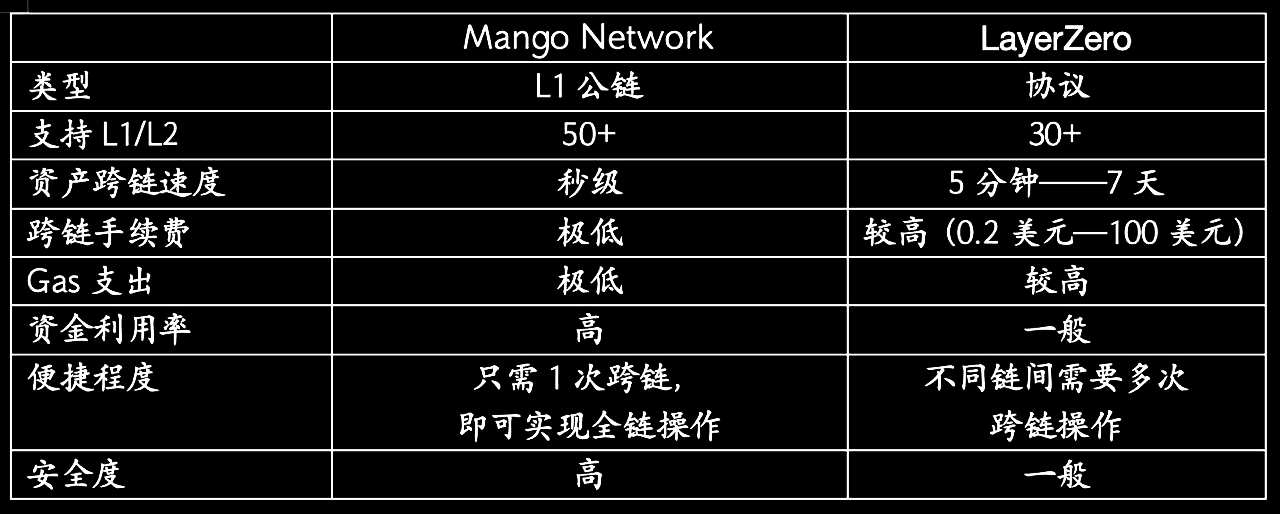
The full-chain application realizes the seamless connection of heterogeneous public chains, solves multiple pain points such as user experience fragmentation and liquidity fragmentation existing in Web3 applications and DeFi protocols, and builds one-stop liquidity services through main chain contracts and module contracts. network, bringing users a unique trading experience.
Full-chain liquidity pool spurs DeFi innovation
Mangos full-chain application makes it possible to build a full-chain liquidity pool. In the past, DeFi projects needed to build separate liquidity pools on each public chain, which reduced capital efficiency and increased the complexity of cross-chain operations for users. Based on Mangos full-chain application, it is now possible to build a one-stop liquidity pool that supports full-chain assets and realizes full-chain operations.

Mango’s liquidity service network has the following advantages:
Unified user experience: Users can access DeFi applications on other chains through the unified entrance of the Mango public chain.
Low cost: The process of realizing cross-chain assets through Mango Network has extremely low handling fees and lower gas costs.
High asset liquidity: Users only need to use 1 Token as gas fee to freely transfer assets between different chains.
Efficient and secure: Developed based on Move language, it has inherent security advantages.
Users can transfer on-chain assets to the liquidity pool deployed on the Mango main chain through Mango Network, and then participate in DeFi operations on any chain through module contracts deployed on the target chain. This approach reduces the complexity of cross-chain operations, improves security, reduces user gas consumption, and has no transactional wear and tear.
For example, users can cross-chain ETH assets to the liquidity pool of the Mango main chain and interact with Pancake Swap on the BNB chain through Mangos module contract on the target chain. This means that users who only hold single token assets such as BTC or ETH can also participate in DeFi projects on any chain, which greatly increases the potential size of the liquidity pool, thus giving rise to full-chain liquidity lending and full-chain staking. , new flash loans, new algorithmic stable coins and other innovative DeFi applications.
For example, full-chain liquidity lending is based on the single currency pool of each public chain as the core, with Mango Network as the bridge and settlement layer. The single currency pool of each public chain allows users on any chain to provide liquidity for the protocol. Compared with the Aave protocol that provides liquidity on a single chain for lending and borrows third-party cross-chain bridges to achieve cross-chain, all operations of full-chain liquidity lending based on Mango can be performed on any chain, which will significantly improve the fund utilization of the lending protocol. Rate.
BeingDex, an innovative full-chain pending order matching trading platform
BeingDex is a decentralized exchange developed based on Mango Move, which supports pending order matching transactions on the entire chain. Its outstanding innovations include: wallet point-to-point matching transactions, using an order book model, supporting K-line charts, and eliminating the need for a liquidity pool.
This method is significantly different from Uniswap V3. Order book trading can provide greater trading depth and bring higher price transparency. Users can see all pending orders, making it easier for users to find the optimal trading price. At the same time, the Mango Move language uses static calls and the execution sequence cannot be changed, which can effectively resist MEV attacks and help users further reduce transaction slippage.
BeingDex supports assets on the entire chain, including Tokens, NFTs and inscriptions, and can be used as a liquidity portal to bring full-chain liquidity into various Web3 applications. The BeingDex team is also constantly expanding its service boundaries, providing users with one-stop asset management services through Web3 key infrastructure such as Crypto Wallet, DeFi, machine gun pool, POS pledge pool, IDO, NFT trading platform, decentralized social applications and DAO. .
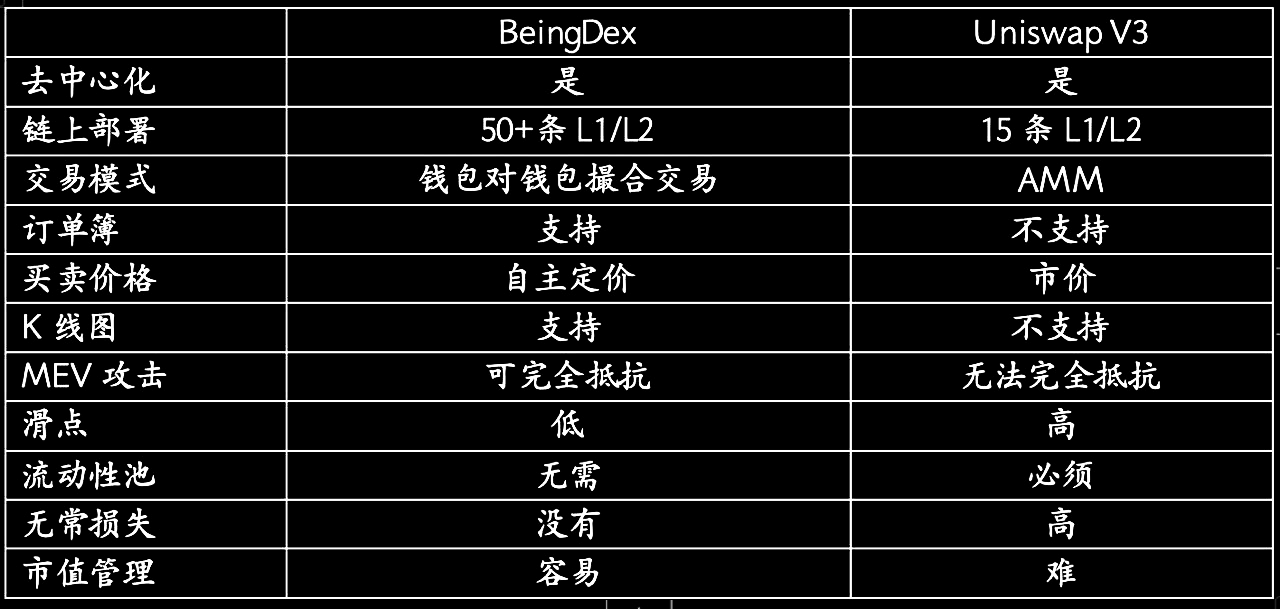
Overall, full-chain transactions are an inevitable trend in the development of Web3 applications. Full-chain transactions can improve asset liquidity, improve capital efficiency, reduce transaction costs, expand application scenarios, and provide users with more convenient, efficient, and rich services.
The advent of Mango Network has brought new opportunities to the development of the blockchain industry. It is expected to become a leader in full-chain interoperability and prepare for industry paradigm shifts as a transaction-based full-chain infrastructure in the Web3 field.
Interpretation of the key points of the Mango Network white paper
A. Positioning: Transaction-based full-chain infrastructure
Keywords: L1 new public chain, DPoS, full-chain application, Move language, modularization
B. Technical Highlights
1. Supports full-chain applications - users only need to prepare one type of Token as Gas to interact and operate on various heterogeneous blockchains;
2. High performance - up to 297.45 K+TPS, sub-second settlement, low gas fee, and good user experience;
3. High security - Based on Move language, static language combined with smart contracts, the project code will not be tampered with and can effectively resist attacks;
4. Modularity - an architecture that decomposes blockchain functions into multiple independent modules. Each module can focus on specific functions, such as consensus, execution, data availability, etc., and can be customized according to different needs to meet different application scenarios. needs; modular blockchain has good scalability and can be expanded by adding or removing modules to meet growing needs; at the same time, modularity can also be improved by decomposing different functions into different modules safety.
C. Implementation of Mango full-chain application
Mangos full-chain application adopts the architectural design of main chain contracts and module contracts. Among them, the main business logic will be deployed on the Mango main chain to achieve the overall coordination function. On other public chains, by deploying remote access modules, it is possible to interact with end users, such as obtaining input and output results.
The specific operation process is: the user inputs through the remote module on the new chain, and the module transmits the input information across the chain to the Mango main chain. The main chain outputs the result after processing, and then returns the result to the corresponding remote module on the new chain. In this way, the module presents a localized interactive experience to the user. In addition, in order to meet the expansion needs, certain functional modules within the main chain can also be deployed on other public chains to form a virtual main chain system.
Generally speaking, this architectural design achieves the goal of full-chain interconnection of cross-chain applications through abstract decoupling between the main chain and module contracts. Through a simple interactive interface, users can use full-chain services distributed on multiple chains, making the experience more convenient and unified.
D. Technical advantages of full-chain applications
It provides the settlement layer and execution layer between heterogeneous public chains. Previously, users needed to use cross-chain bridges such as LayerZero to transfer assets between heterogeneous chains, and prepare corresponding Tokens as Gas on different chains. Now, users only need to migrate assets to the Mango main chain through Mangos own cross-chain bridge, and then they can interact and operate on any target chain through the module contract. Compared with cross-chain bridges, full-chain applications have significant advantages:
1. Easy to expand - the main logic of the program is processed on the Mango main chain, and the application has a unified status record. After users deploy contracts on a new chain, they can inherit all state records and liquidity from the entire main chain without having to reinvent the wheel.
2. Better user experience - users do not need to care about which chain the program is deployed on, and can access applications from the main chain of the entire chain just like accessing local programs; there is no need to frequently use cross-chain bridges; only 1 As Gas, this Token can operate and interact on any chain.
3. Facilitate cross-chain integration - when other applications integrate the program, they only need to connect on the main chain of the entire chain to use all its functions and liquidity.
E. The composition of the Mango public chain infrastructure protocol
1. ZK zero-knowledge proof - realizing anonymous transactions, privacy protection and cross-chain interaction authentication
2. Distributed storage - using IPFS to store data to ensure data redundancy, reliability and scalability
3. MgoDNS domain name service - is a distributed domain name solution based on cross-chain protocols, providing domain name and domain name data analysis services for non-intermediary networks. MgoDNS is decentralized, with the blockchain as its bottom layer and the traditional Internet as its upper layer. MgoDNS can also connect various types of public chains and alliance chains to form a super hub connecting various blockchains.
4. Mango client - maintains a consistent copy of the valid state of the system and is used for auditing and building transactions or operational services.
F. Roadmap and Timetable
Mango Network will launch a testnet in the second quarter.
Its ecological application projects, Being Wallet and BeingDex (order book-style full-chain pending order matching and trading platform), have been deployed on the development network.
About Mango Network
Mango Network is a Layer 1 public chain based on the Move language. It aims to become a transaction-based full-chain infrastructure network. It implements full-chain applications through modularization and builds a one-stop liquidity service network to bring more security and credibility to users. , diverse assets, convenient and independent trading experience. MGO is its native token.
Mango Network was developed by MangoNet Labs, a technology company focusing on Web3 infrastructure. Its vision is to help 1 billion users successfully apply Web3.
For more dynamic developments, please see the official websiteX account。



